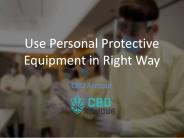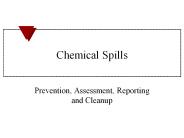Chemical Protective Clothing Ppe Hand Protection PowerPoint PPT Presentations
All Time
Recommended
Respiratory Protection Personal Protective Clothing EPA Levels of Protection Site Control/Decontamination Larry Wong, CIH University of California Office of the President
| PowerPoint PPT presentation | free to view
University of California Office of the President. Personal Protective Equipment (PPE) ... Helmet. or Hood. Full. Face- Piece. Half. Mask. Type of Respirator. APRs ...
| PowerPoint PPT presentation | free to download
Wear PPE always and at all places where it is required. Follow the directions for usage, keep them clean, and check to see whether they still provide enough protection regularly.
| PowerPoint PPT presentation | free to download
Wear PPE always and at all places where it is required. Follow the directions for usage, keep them clean, and check to see whether they still provide enough protection regularly.
| PowerPoint PPT presentation | free to download
Title: Personal Protective Equipment (PPE) Author: INFORMATION TECHNOLOGY Last modified by: Windows User Created Date: 1/18/2006 4:23:28 PM Document presentation format
| PowerPoint PPT presentation | free to view
PERSONAL PROTECTIVE EQUIPMENT PPE
| PowerPoint PPT presentation | free to view
ATS Global provides a long lasting & high quality hand protection gloves that is essential for workplace safety. For more information visit: https://www.atsglobal.com.au/
| PowerPoint PPT presentation | free to download
Personal Protective Equipment (PPE) Chapter 6 National Pesticide Applicator Certification Core Manual * Protect yourself when mixing and loading. Label PPE ...
| PowerPoint PPT presentation | free to download
Personal Protective Equipment (PPE) ... This and the next two s discuss the Application portion of 29 CFR 1910.132 (a).
| PowerPoint PPT presentation | free to download
Wear PPE always and at all places where it is required. Follow the directions for usage, keep them clean, and check to see whether they still provide enough protection regularly.
| PowerPoint PPT presentation | free to download
Make sure the cartridge or filter is rated for the pesticide you are using. Read the label ... Chemical Cartridge and Canister Respirators. Both half-face mask ...
| PowerPoint PPT presentation | free to view
Michigan State University and. Michigan Department of Agriculture. CHAPTER 6 ... No sandals! Consider wearing unlined, rubber boots... even if not required ...
| PowerPoint PPT presentation | free to view
Consider wearing unlined, rubber boots... even if not required. Hang pant legs outside the boots! Hats & Hoods. Liquid-proof with a wide brim ...
| PowerPoint PPT presentation | free to view
Michigan State University Extension. Pesticide Safety Education Program. CHAPTER 6 ... No sandals! Consider wearing unlined, rubber boots... even if not required ...
| PowerPoint PPT presentation | free to view
eyewear must wear face shields, goggles or spectacles of one of. the following types: ... Eyewear limitations & precautions specified by. the manufacturer ...
| PowerPoint PPT presentation | free to view
Wear PPE always and at all places where it is required. Follow the directions for usage, keep them clean, and check to see whether they still provide enough protection regularly.
| PowerPoint PPT presentation | free to download
Use work clothing and personal protective equipment (PPE) to ... eyewear. DANGER. Coveralls over. work clothing, chemical- resistant gloves. and footwear, ...
| PowerPoint PPT presentation | free to view
In today's dynamic work environment, ensuring the safety and well-being of employees is paramount. Personal Protective Equipment (PPE) plays a pivotal role in safeguarding workers across various industries. From healthcare to manufacturing, construction to oil & gas, PPE serves as a vital line of defense against occupational hazards.
| PowerPoint PPT presentation | free to download
Respiratory Protection and Personal Protective Equipment
| PowerPoint PPT presentation | free to download
Wear PPE always and at all places where it is required. Follow the directions for usage, keep them clean, and check to see whether they still provide enough protection regularly.
| PowerPoint PPT presentation | free to download
'White Book', 1997, AIHA, Chapters 35 & 36. Guide to Industrial Respirator Protection, NIOSH, 1987 ' ... If oil-lubricated, can overheat changing oil mist into CO ...
| PowerPoint PPT presentation | free to view
PPE is all equipment (including clothing for the protection ... Ear muff; Ear Plug; Respiratory Tract Protection PPE: Hazards: Airborne contaminants like: ...
| PowerPoint PPT presentation | free to view
... gloves, lab coat and safety glasses. Basic, but Important Information ... Safety glasses are designed for impact protection from flying particles and debris. ...
| PowerPoint PPT presentation | free to view
Chemical resistant gloves (when working with hazardous substances) ... Did you know that thicker gloves may increase breakthrough times, but may have ...
| PowerPoint PPT presentation | free to view
Industrial Protective Clothing Fabrics Market Estimated to Expand at a Robust CAGR by 2027
| PowerPoint PPT presentation | free to download
According to Reports and Data, the global healthcare personal protective equipment (PPE) market was valued at USD 5,018.3 million in 2019 and is expected to reach USD 8,024.4 million by the year 2027, at a CAGR of 4.5%.
| PowerPoint PPT presentation | free to download
Personal Protective Equipment’s became a stable gear for the world in an effort to flatten the curve of the COVID-19 pandemic. PPE can be classified as Eye and face protection, Hand protection, Body protection, Respiratory protection and Hearing protection.
| PowerPoint PPT presentation | free to download
Market Size – USD 5.02 billion in 2019, Market Growth - CAGR of 4.5%, Market Trends– Advancements in healthcare personal protective equipment technologies, stringent regulations for good manufacturing practices, and rising focus on safety of clinicians.
PROPER CLOTHING & DRESS IS REQUIRED IN THE MILL AT ALL TIMES ... Steel Toe. Rubber or Chemical. Hearing Protection. Plugs. Muffs. Custom fit. Face Protection ...
| PowerPoint PPT presentation | free to view
Personal protective equipment (PPE) is equipment worn to reduce exposure to hazards that cause serious workplace injuries and illnesses. Chemical, radiological, physical, electrical, mechanical, or other workplace hazards may cause these injuries and illnesses.
| PowerPoint PPT presentation | free to download
THE PERSONAL PROTECTIVE EQUIPMENT AT WORK REGULATIONS 1992 REQUIRE THAT PPE IS ... RISK OF BUMPING HEAD. HAIR ENTANGLEMENT. BREATHING. DUST,VAPOUR and GASES. THE BODY ...
| PowerPoint PPT presentation | free to view
LABORATORY SAFETY PPE PPE Personal Protective Equipment PPE Equipment worn to protect the user from chemicals Examples: Splash goggles Lab coats or jackets PPE ...
| PowerPoint PPT presentation | free to download
Sets out procedures for selecting, providing, and using PPE as part of an ... Always clean protective eyewear after each use, or whenever vision is obscured. ...
| PowerPoint PPT presentation | free to view
Chemical-protective clothing is available in a variety of materials that offer a ... Emergency escape respirator (optional) Coveralls. Gloves, inner & outer ...
| PowerPoint PPT presentation | free to download
CHEMICAL HAZARDS AND PERSONAL PROTECTIVE EQUIPMENTS Editor: Chen-Peng Chen, Ph.D. Department of Occupational Safety and Health China Medical University
| PowerPoint PPT presentation | free to view
Highlights of IH Programs and OSHA Standards INTRODUCTION Hazard Communication Hearing Conservation Personal Protective Equipment Respiratory Protection Heat Stress ...
| PowerPoint PPT presentation | free to view
Awareness-Level Lesson 4 Presentation Hazardous Materials for First Responders, 3rd Ed. Typical Components of PPE Respiratory equipment Protective clothing Structural ...
| PowerPoint PPT presentation | free to view
In today’s fast-paced work environments, ensuring the safety and well-being of employees is paramount. Personal Protective Equipment (PPE) plays a crucial role in mitigating occupational hazards across various industries. Let’s explore the landscape of the PPE market, its growth trends, and the evolving dynamics shaping its trajectory.
| PowerPoint PPT presentation | free to download
welding hood/cutting goggles - leather gloves - protective clothing - acid suit. Fall Protection ... 5 ft & ground examined by competent person showing no ...
| PowerPoint PPT presentation | free to view
The purpose of this discussion is to communicate the importance of using proper ... Use extra care with Dewar flasks and other evacuated glass apparatus; shield or ...
| PowerPoint PPT presentation | free to view
Personal Protective Equipment (PPE) Chapter 6 National Pesticide Applicator Certification Core Manual
| PowerPoint PPT presentation | free to download
Personal Protective Equipment Department of University Safety & Assurances www.safety.uwm.edu Why PPE is Important Personal protective equipment (PPE) is designed to ...
| PowerPoint PPT presentation | free to view
Workers responded that they do not use PPE more regularly ... Sandals. Long hair (allowed if put up) Jewelry. Loose clothing (can get caught in machinery) ...
| PowerPoint PPT presentation | free to view
MAINTENANCE PPE Personal Protective Equipment Safety Orientation Think about Personal Protective Equipment as the last choice when ...
| PowerPoint PPT presentation | free to view
Personal Protective and Lifesaving Equipment for Construction PPE Hazard free environment Protected against potential hazards Purpose of PPE Who pays for PPE?
| PowerPoint PPT presentation | free to download
Hand Safety Part-1 Unguarded or fixed open blade utility knives like the one pictured above are prohibited on URS projects for any types of cutting operations.
| PowerPoint PPT presentation | free to download
To understand why a worker should not wear personal protective equipment outside ... To know how to store personal ... Types of Protective Clothing. Aprons ...
| PowerPoint PPT presentation | free to view
OSHA Office of Training and Education * * * 1910.132(a) * * Protective clothing comes in a variety of materials, each suited to particular hazards.
| PowerPoint PPT presentation | free to download
PERSONAL PROTECTIVE EQUIPMENT Problems Associated with PPE Use Heat stress Dermatoses Restricted vision and dexterity Restricted communication/hearing
| PowerPoint PPT presentation | free to view
* Lots of Pinch Points Here on an Old Rig ... like the auger stem on a drilling rig ... Tahoma Arial Wingdings Webdings Verdana Times New Roman Corp HSE ...
| PowerPoint PPT presentation | free to download
ACUTE - direct threat that shows up almost immediately after ... Never Pipette by Mouth. Do Not Smell or Taste Chemicals. Constrain Long Hair and Loose Clothing ...
| PowerPoint PPT presentation | free to view
... material that you know the hazards of and are comfortable cleaning up that you have the ability to clean up assess the hazard ... effects of biologicals ... waste ...
| PowerPoint PPT presentation | free to download
Personal Protective Equipment (PPE) Market size forecast is likely to hit USD 67.66 billion by 2023. PPE market analysis pegs revenue growth at 7.3%. Core PPE manufacturing companies include RockFall Ltd., 3M Co., Alpha Protech, Ltd., Honeywell, JAL Group and DuPont. Rising employee safety and health concerns, along with high number of industrial fatalities in unregulated regional industries will drive the global personal protective equipment (PPE) market size.
| PowerPoint PPT presentation | free to download
CHEMICAL CARCINOGENS What is a carcinogen? Any substance that is capable of causing cancer. ... Ionizing radiation Natural products (progesterone, safrole) ...
| PowerPoint PPT presentation | free to download
Human Pesticide Protection ...
| PowerPoint PPT presentation | free to view
























































